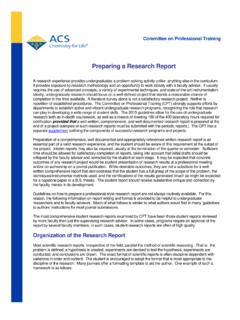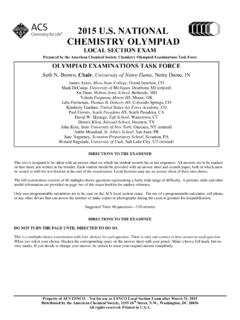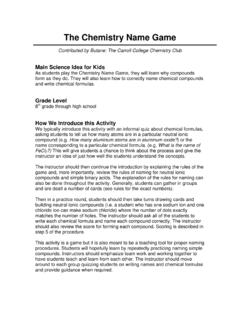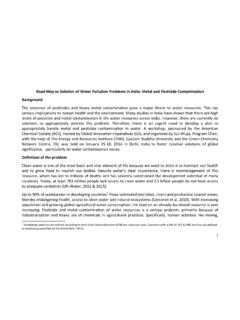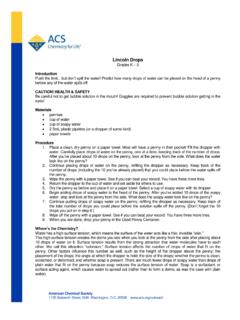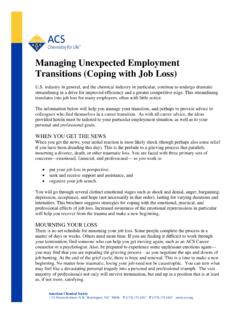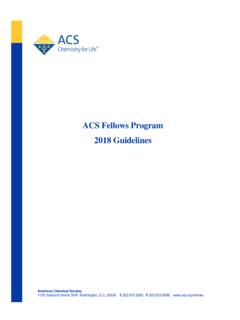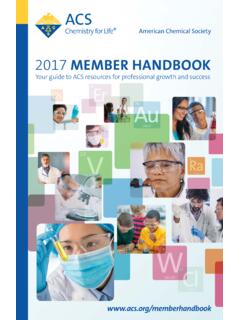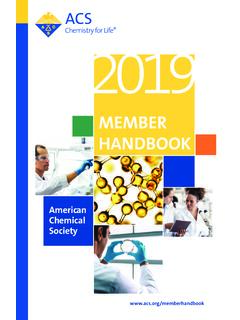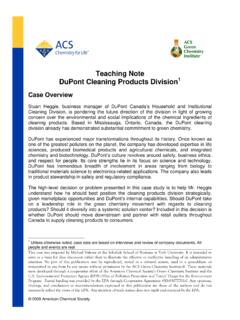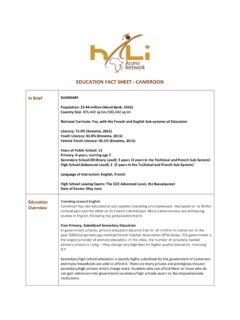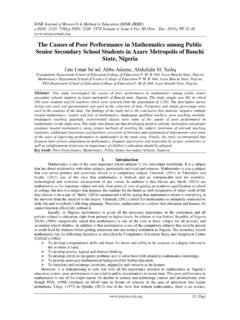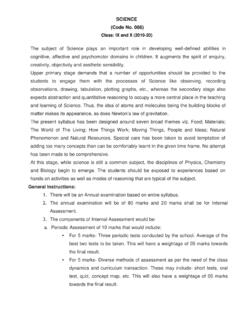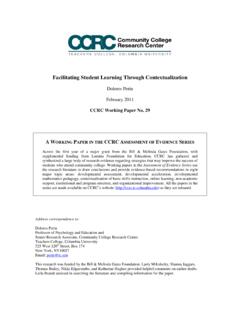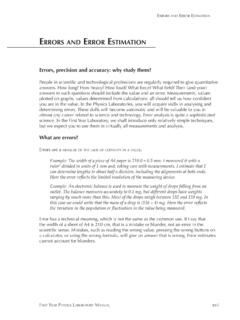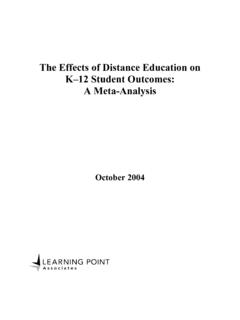Transcription of ACS Secondary Safety Guidelines - American Chemical Society
1 American Chemical Society . Guidelines for Chemical laboratory Safety in Secondary Schools Published by American Chemical Society 1155 Sixteenth Street, NW. Washington, DC 20036. COPYRIGHT 2016. 2. American Chemical Society . Guidelines for Chemical laboratory Safety in Secondary Schools Disclaimer: The guidance contained in this publication is believed to be reliable but is not intended to specify minimal legal standards or to represent the policy of the American Chemical Society . No warranty, guarantee, or representation is made to the Amer- ican Chemical Society as to the accuracy or sufficiency of the information contained herein, and the American Chemical Society assumes no responsibility in connection therewith. Users of these Guidelines should consult pertinent local, state, and federal laws and legal counsel prior to initiating any accident prevention program. Guidelines for Chemical laboratory Safety in Secondary Schools TABLE OF CONTENTS. ACKNOWLEDGMENTS.
2 6. FOREWORD .. 8. Suggested Learning Outcomes .. 10. Recognize the Hazards General Safety Rules .. 18. Health and Safety Organizations ..19. Hazard versus Risk ..20. Globally Harmonized System for Classifying Hazardous Chemicals ..21. National Fire Protection Association Hazard Identification System .. 24. Flammable Materials ..26. laboratory -Specific Signage for Flammables .. 27. Fire Triangle Fire Tetrahedron Classes of Fires Types of Fire Extinguishers Chemical Product Labels ..30. Safety Data Sheets ..31. SDS Section Numbers and Headings Terms that All Chemistry Teachers and Other Science Teachers Should Know ..32. Routes of Exposure Types of Exposure Limits Examples of Acute Toxicants Examples of Chronic Toxicants Incompatible Chemicals ..36. Common laboratory Hazards .. 38. Waste Disposal Considerations ..41. Chemical Hygiene Plan ..42. Basic laboratory Glassware and Equipment ..43. Assess the Risks of the Hazards Before an Experiment ..52. During an Experiment.
3 54. What if an Emergency Occurs? .. 54. After an Experiment ..55. Minimize the Risks of the Hazards Before an Experiment ..58. During an Experiment .. 61. After an Experiment ..62. Prepare for Emergencies from Uncontrolled Hazards Emergency Preparation .. 66. Recommended Safety Equipment Exits and Emergency Drills Emergency Response Special Considerations in the laboratory ..67. Broken Glassware Fires Spills Mercury Spills Volatile Liquid Spills APPENDIX A: GLOSSARY OF ABBREVIATIONS AND ACRONYMS .. 72. APPENDIX B: SAMPLE Safety Guidelines AND Safety CONTRACT .. 74. Acknowledgments This guide was produced by the ACS Committee on Chemical Safety (CCS) Task Force for Safety Education Guidelines . TASK FORCE MEMBERS. TASK FORCE CO-CHAIRS Two- and Four-Year Kirk Hunter, Texas State Technical Undergraduate Education College, Waco, TX. Georgia Arbuckle Jack Breazeale, Francis Rutgers University, Camden, NJ. Marion University, Florence, SC. Edgar Arriaga University of Minnesota, Minneapolis, MN.
4 Secondary Education Joe Crockett Jennifer Panther Bishoff Bridgewater College, Bridgewater, VA. Southern Garrett High School, Mountain Lake Park, MD Julie Ellefson Harper College, Palatine, IL. Regis Goode Ridge View High School, Columbia, SC Ken Fivizzani RETIRED. Karlo Lopez Nalco Company, Naperville, IL. California State University Bakersfield, Bakersfield, CA Steven Fleming Temple University, Philadelphia, PA. Patricia Redden Saint Peter's University, Jersey City, NJ Frank Torre Springfield College, Springfield, MA. 6. Graduate and In addition to the Task Force members, Postgraduate Education the contributions of the following people and groups to this document Dom Casadonte are gratefully acknowledged. Texas Tech University, Lubbock, TX. David C. Finster Anna Dunn Wittenberg University, Springfield, OH. University of Michigan, Ann Arbor, MI. Elizabeth M. Howson Scott Goode 2015 2017 CCS CHAIR. University of South Carolina, Morristown, NJ. Columbia, SC.
5 ACS Committee on Robert H. Hill Chemical Safety (CCS). PAST CHAIR (2012 2014). COMMITTEE ON Chemical Safety (CCS) ACS Committee on Battelle Memorial Institute, Professional Training (CPT). Atlanta, GA. ACS Division of Chemical Neal Langerman Health and Safety (CHAS). Advanced Chemical Safety , Inc., San Diego, CA. Marta U. Gmurczyk ACS STAFF LIAISON TO THE CCS. ACS, Washington, DC. Raihanah Rasheed ACS ASSISTANT STAFF LIAISON TO THE CCS. ACS, Washington, DC. 7. FOREWORD. All science teachers should have a strong foundation in the science Safety culture appropriate to their educational level. Although this requirement applies to elemen- tary, middle, and high school science educators, this publication is designed mainly for the high school chemistry teacher. RAMP. The Guidelines in this publication were developed using the RAMP concept for scientific RAMP b is an acronym to help educators and students keep science Safety in the forefront of their work in a laboratory environment.
6 Robert H. Hill and David C. Finster coined the term in their textbook laboratory Safety for Chemistry RAMP stands for: R Recognize the hazards A Assess the risks of the hazards M Minimize the risks of the hazards P Prepare for emergencies from uncontrolled hazards 8. Industrial scientists often state that it is easy to tell when an individual's attention to laboratory Safety began. Those graduates with a bachelor of science, master of science, or doctoral degree, who truly understand the importance of labora- tory Safety , had their Safety education start at the Secondary education level and continue throughout their undergraduate studies. These Guidelines were developed to help high school teachers in all science subjects to progressively increase their understanding of best practices to ensure the Safety of their students and themselves in the scientific learning experience. It is hoped that these Guidelines will help teachers to nurture a culture of science Safety early in students' academic and professional careers.
7 It is also hoped that these guide- lines will prepare teachers to handle any incident or emergency situation that might arise in the science classroom or laboratory . a Source: Hill, R. H.; Finster, D. C. laboratory Safety for Chemistry Students; John Wiley & Sons, Inc.: Hoboken, NJ, 2010; p 1-7. b See Appendix A for a glossary of abbreviations and acronyms used in these Guidelines . 9. Suggested Learning Outcomes Below are the outcomes that teachers should expect of students. Teachers using these Safety education Guidelines can design lessons and assessments to ensure that these outcomes are integrated into curricular activities. Students should be able to define, explain, and understand the following terms and concepts at a basic level. RECOGNIZE THE HAZARDS. Terms to Define or Explain Acute toxicity Flash point Personal protective Allergen Globally Harmonized equipment (PPE). Asphyxiant System (GHS) Pyrophoric Autoignition Halogen Radioactivity temperature Hazard RAMP system Carcinogen Incompatible chemicals Risk Chronic toxicity Mutagen Runaway reaction Compressed gas National Fire Protection Safety Data Sheet (SDS).
8 Corrosive Association (NFPA) Teratogen Cryogen Organ toxicant Toxicity Electrical hazard Occupational Safety and Health Environmental Administration (OSHA). Protection Agency (EPA). Flammability 10. Basic Terminology and Concepts 1. Differentiate between hazard and risk. 2. Define acute and chronic toxicity and cite some examples of each. 3. State the general effects that corrosives have on the skin. 4. State the general hazards associated with the use and storage of flammable chemicals commonly used in the laboratory . 5. Explain the statement The dose makes the poison.. 6. Explain why reducing the scale reduces the risk. Labels, SDS, and PPE. 7. Explain the meaning of the GHS hazard pictograms. 8. Interpret information given on an NFPA diamond. 9. Identify and describe the use of basic PPE. Basic laboratory Safety 10. State the general rules for working safely in a Chemical laboratory environment. 11. Describe the possible routes of exposure for a hazardous material.
9 12. Explain why food and drinks are not permitted in a Chemical laboratory . 13. List the general considerations for appropriate waste disposal. Regulatory Agencies and Regulations 14. State the purpose of regulatory agencies ( , OSHA, EPA). 11. ASSESS THE RISKS OF THE HAZARDS. Labels 15. Interpret the information given on a manufacturer's label for a Chemical substance. MINIMIZE THE RISKS OF THE HAZARDS. General Concepts 16. Explain why the buddy system is used in laboratory environments. 17. Explain why various flammable and combustible materials should be available in limited quantities in laboratories. 18. Discuss the Safety precautions or best practices that must be followed when transferring flammable materials from one container to another. 19. Explain the reasons for following written protocols and standard operating procedures (SOPs) for laboratory activities and experiments. 20. Explain the purpose of good housekeeping. 21. Demonstrate good housekeeping by maintaining a clean and orderly workspace.
10 22. Identify and demonstrate the appropriate use of personal protective equipment (PPE) for a given laboratory activity. 23. Identify and demonstrate the appropriate use of common laboratory Safety equipment ( , Safety shower, eyewash station, fire blanket, fire extinguisher). 24. Describe and demonstrate methods to prevent spills due to falling containers, or when transferring and transporting chemicals. 12. 25. Describe and demonstrate the appropriate use of common laboratory equipment for heating ( , Bunsen burners, hot plates, alcohol burners, candles, heat guns, laboratory ovens). 26. Describe the basic precautions for the following common laboratory operations: chromatographic separations, distillations, refluxing, recrystallization, extraction, stirring. 27. Explain the hazards of mercury and ways to minimize exposures, including plans to eliminate mercury-containing equipment from laboratories. Planning 28. Prepare a Safety checklist for all laboratory activities using the RAMP concept.
